Growing Apple Florin
The Florina apple tree is a picky variety. It appeared as a result of the work of French breeders, by using the genome of several varieties: Starking, Rum Beauty and Jonathan.
- Characteristic
- Description of the tree
- Description of fruits
- Fruit application
- Taste characteristic
- Cultivation regions
- Yield
- Pollinating varieties
- Winter hardiness
- Disease and pest resistance
- Advantages and disadvantages of the variety
- Landing
- Timing
- Seat selection
- Sapling selection
- Pit preparation
- Landing technology
- Care
- Watering
- Top dressing
- Ovary normalization
- Pruning and shaping the crown
- Preparing for winter
- Pest prevention
- Features of ripening and fruiting
- Harvesting and storage
- Variety subspecies
- Gardeners reviews
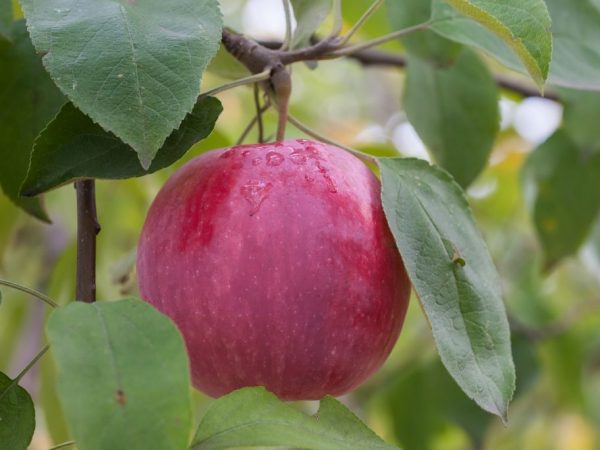
Growing Apple Florin
Characteristic
Florina variety bears fruit periodically, taking a break every 3 years. The annual rationing of the crop improves the presentation. This keeps the apples from getting smaller. Extra ovaries should be removed. In gardens, this is done by hand, and in industrial farms - with the help of chemicals.
This is a winter variety. Harvesting begins closer to October. It has excellent performance in areas with a warm climate. After lying down for a while, the fruits only get better.
Description of the tree
An adult tree reaches a height of 3 m. On lands not rich in nutrients or on a dwarf rootstock, it grows up to 2 m. The crown of the tree is dense due to the abundance of foliage. Young trees are characterized by increased shoot formation. Has mixed fruiting. Most of the fruits are accounted for by annual growths.
Flowering takes place for a long time.
Description of fruits
The apples are round. By weight they reach 150 g. The peel is not thick and elastic. Subcutaneous blotches of light color are visible on the surface of the fetus. Mostly the color of apples is red. It has stripes or blush with a slight bloom of bluish color. The pulp is dense, greenish-white, juicy. When the apple is cut, a wonderful delicate aroma is felt.
Fruit application
The fruits are consumed fresh. They also make a delicious juice. Despite the sweetness, the variety is not used in the production of jam, jam and marshmallows.
Taste characteristic
The fruits are rated at 4.8 points. They have an unpleasant taste: sweet with a subtle hint of sourness. A few months after harvest, they resemble melon in their taste and aroma.
Winter apples usually acquire their characteristic taste after some time, and Florina fruits can be consumed by removing them from the tree immediately after the onset of ripeness.
Cultivation regions
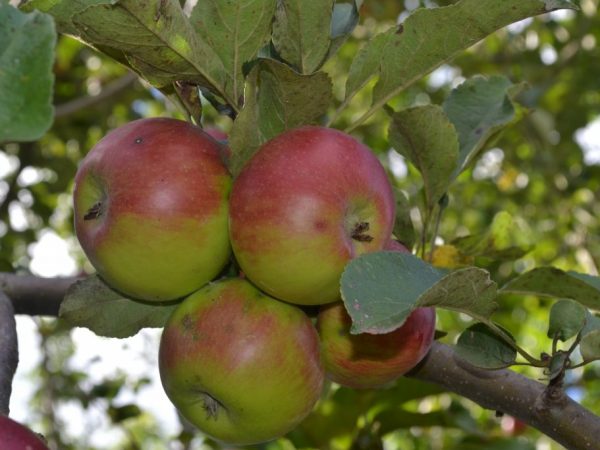
This variety does not tolerate frost very well.
For the first time, the Florin variety began to be planted on Ukrainian lands. It has been cultivated commercially since 1980. It was from this time that apple plantations were laid.
The apple tree, due to its low frost resistance, has spread in zones of Russia with a temperate climate (middle zone).
Yield
Depending on the rootstock used, 70 to 150 kg of fruit are removed from the tree. It also affects the onset of the fruiting period:
- vigorous - for 7 years;
- semi-dwarf - for 5 years;
- dwarf - for 3 years.
Pollinating varieties
Culture is self-fertile. If you do not provide additional pollination, the fruit is set up to 26% of the possible amount. To increase the volume of the ovaries, pollinators should grow next to the apple tree. Such species as Ruby Dooks, Liberty, Golden Delicious, etc. cope with this task.
Winter hardiness
Florina variety does not differ in winter hardiness. In cold conditions, it does not take root and freezes out. Drought tolerance also shows poor results.
Disease and pest resistance
In the process of crossing, breeders achieved high resistance of the variety to such diseases and pests as:
- powdery mildew;
- moniliosis and bacterial burn;
- scab;
- aphid.
Advantages and disadvantages of the variety
Advantages of the Florina apple variety:
- disease resistance;
- high taste and presentation;
- safety up to 6 months;
- the ability not to lose their presentation during transportation;
- high productivity.
Disadvantages:
- fruiting occurs periodically, but compliance with the rules of agricultural technology allows you to level this problem;
- weak winter hardiness and drought resistance.
Landing
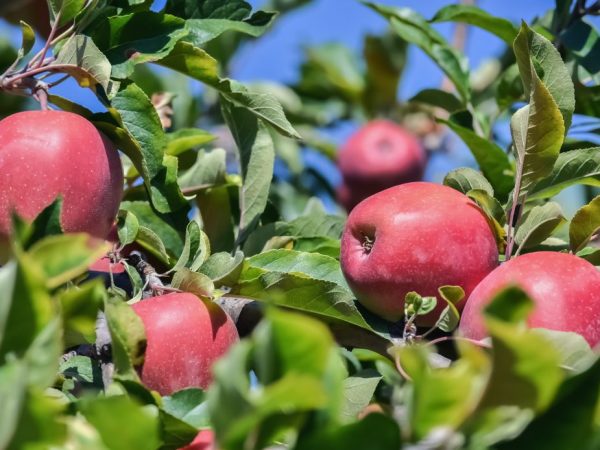
Excellent and high yield
For proper development and constant increase in yield, you need to carefully consider the process of planting the selected seedling.
Timing
Start planting the Florin apple tree in early spring or autumn. Each method has its own advantages. When planting in the autumn, you can choose the best one from a large number of seedlings, paying a reasonable price.
Warm autumn will allow the roots to harden well, and the plant will accumulate strength until the cold weather. With a belated planting, the seedling may die without having time to get stronger.
When planted in late spring, apple trees grow rapidly and develop a root system. The optimal time for the spring procedure is April - May. At a later date, the plant takes root hard.
By purchasing a seedling in the fall, you can plant it in the spring. In this case, lay the apple tree in the ground obliquely into a trench dug up to 40 cm deep with the top to the south. Sprinkle the roots and 1/3 of the trunk with earth.
Seat selection
An important step is choosing a landing site. Pay attention to the sunny part of the site. In a shaded area, poor ovary formation is possible and, as a result, the formation of small and sour fruits. The distance to neighboring trees should not be less than 3 m.
An important factor is the direction of the wind. In northerly winds, it is better to hide Florin's apple tree behind buildings. In the absence of drafts, more intense insect pollination occurs. The seedling takes root well both in black soil and in soils with a clay base. However, in terms of acidity, it is better to choose neutral or slightly acidic soil.
Sapling selection
When everything is ready for planting, they start choosing a seedling. It is better to give preference to young trees grown in the same area where the procedure will take place. When examining a seedling, it is important to take into account several factors that contribute to better adaptation of the apple tree:
- age - 1-2 years. Such a seedling takes root easily. The one-year-old tree has no branches yet. At the age of 2, there are already two branches;
- the trunk is even and without defects, the bark is clean. Under it the wood is juicy green. If it is brown, the tree is not viable;
- the seedling has several main roots with a net of thin roots. They must be free from defects;
- the graft is located 8 cm above the root system.
Pit preparation
According to the rules of agricultural technology, a hole is dug and fertilized long before the tree is planted. When planting in autumn, it is prepared in a month, and in spring - from autumn. This requires:
- clean the planting site of weeds, roots and do not plant in the place where the apple trees grew before;
- the pit should be 80 cm deep and 1 m in diameter;
- discard the top layer of soil to the side.Add 2 buckets of humus, 800 g of ash to the ground and mix thoroughly;
- fill a third of the soil back into the pit, forming a hill in the middle;
- drive in a stake in the middle for tying a seedling;
- pour two buckets of water over the pit.
Landing technology
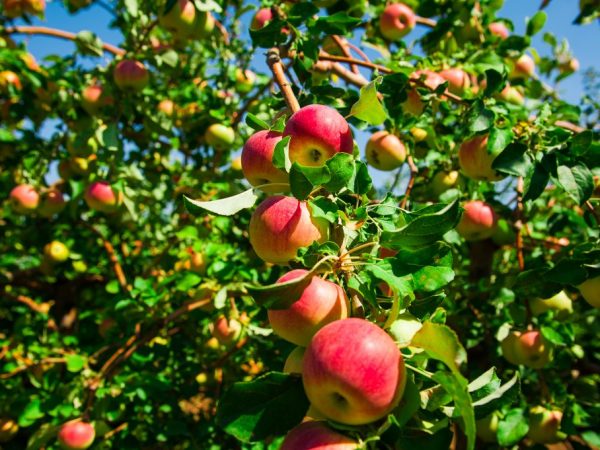
To get fruit, you need the correct planting of a seedling.
Correctly carried out planting contributes to the rapid adaptation of the tree to a new place and active growth. The technological process consists of the following stages:
- the day before planting, the roots of the apple tree are soaked in water, into which you can add the growth stimulator "Epin Extra" (description of use in the instructions);
- before planting, they are dipped in a chatterbox made of clay, water and mullein;
- place the roots evenly over the hill;
- shaking the seedling, cover the roots with prepared earth;
- the grafting site should be 5 cm above ground level and directed to the south;
- compact the soil around the trunk and tie the tree to a support;
- pour 2 buckets of water over the tree;
- carry out mulching, stepping back a little from the trunk.
Care
After planting and throughout its life, the tree needs proper and timely care.
Watering
During the first 3 years, the trunk circle must be constantly moistened. Mature trees do not need this: they are watered only during dry summer.
Watering is required during such periods:
- awakening of the kidneys;
- ovary formation;
- 2 weeks before harvest;
- moisture-charging irrigation is needed in the absence of rains in October.
The basic rule is the flow of water to a depth of 60 cm.
Water volume depending on the age of the tree:
- up to 3 years - 3 buckets of water;
- up to 5 years - 8;
- over 5 - 15.
Use soil loosening and mulching to protect the surface from crusting and rapid evaporation of moisture.
Top dressing
Over the entire growing season, the tree needs different types of feeding:
- in April, after watering, root top dressing (for 10 liters of water - 100 g of urea);
- foliar feeding is needed for trees up to 3 years old to build foliage;
- in May, along the near-trunk circle, at a short distance from the trunk, we evenly distribute humus and loosen it. In order for the fertilizer to get to the roots, abundant watering is necessary;
- in July, they feed the apple tree by diluting 150 g of superphosphate and 120 g of potassium in 30 liters of water. We pour the resulting solution into the holes along the perimeter of the trunk circle;
- after harvesting, we add a mixture of 300 g of potassium and 300 g of phosphate, dissolved in 30 liters of water, into the trunk circle. In the absence of rain, we carry out preliminary watering.
Ovary normalization
The operation of rationing the ovaries is necessary to improve the quality of the future harvest. This is started 2 weeks after flowering. Observing the distance between the ovaries of 18-20 cm, only the largest ones are left.
Pruning and shaping the crown
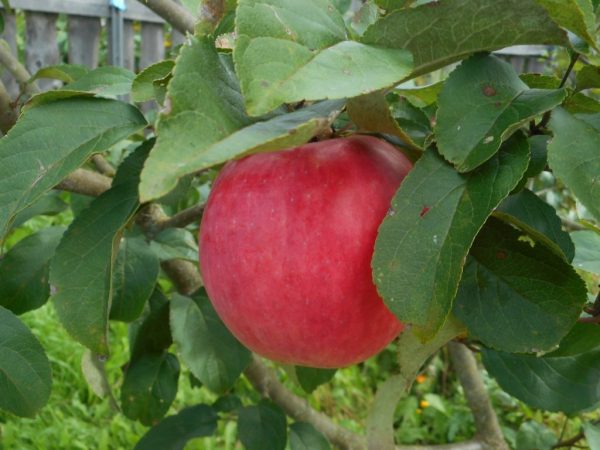
Apple trees should be rejuvenated
The process of crown formation is necessary not only to give the tree a beautiful appearance and prevent thickening, but also to rejuvenate the apple tree.
At the age of 1, Florin's apple tree is pruned when it reaches 80 cm. The buds that remain give growth to new branches. They will continue to be formed next year.
A biennial tree requires an emphasis on the center and skeletal branches. The remaining shoots are pruned “under the ring”. The branches that are directed to the sides are shortened by 30 cm. Later, as soon as the tree grows to the required height, the central branch is cut off.
With an increase in the age of the apple tree, its thinning continues, if necessary using sanitary pruning to prevent the development of diseases.
Preparing for winter
In preparation for the cold weather, seedlings require special care. Protecting them from frost, wrap the trunk and skeletal branches with breathable material (thick paper, burlap). The branches link together. Put a layer of manure or earth mixed with peat in the area of the trunk circle.
In adult Florin apple trees, whiten the trunk. Tie spruce branches around the tree to keep out rodents. Cover the root area with mulch.
Pest prevention
The Florina apple tree can be subject to pest infestations. Most often it is attacked by two types of parasites:
- leaf roll. Caterpillars form a cocoon from the leaves, where they turn into a pupa. To combat them, use the drug "Calypso", which is used before flowering, "Ditox" - after (description of use in the instructions). For prophylaxis in the fall, collect and burn the foliage, regularly whitewash the trunk. Lure birds by placing feeders or collect pests by hand;
- apple blossom beetle. As soon as the buds open, a small beetle wakes up and begins to eat them. Then he switches to the buds, where he lays eggs, and the larvae that appear from the inside eat the bud. Using drugs such as "Iskra" and "Karbofos", during the period when buds open, you can get rid of these parasites. Whitewash the tree trunk as a preventive measure. Loosen the soil of the trunk circle. Use trapping belts. Shake insects onto the fabric by spreading it under the tree.
Features of ripening and fruiting
From mid-September, the apple tree enters the ripening phase. The fruits form and take on color.
Fruiting begins in the second half of October in trees over 4 years old. In the first year, the number of apples reaches 10 kg. The active phase falls on the 7th year. The harvest can be 70 kg per tree.
Harvesting and storage
The fruits are removed from trees very carefully in dry weather. Start at the bottom of the tree, moving towards the top. There is no need to wash apples before storing. Sort immediately. Whole fruits are placed in boxes in three layers. The beaten are allowed to juice.
Florin apples are stored in the cellar until spring. You can increase this period by putting paper between the rows. Then they can persist even until the beginning of summer.
Remove fruits that have started to spoil regularly.
Variety subspecies
There are the following subspecies of the tree:
- red - not the most popular option, it turns out on a strong rootstock;
- the columnar shape simplifies the care of the crop and saves territory;
- winter - yields a harvest at the latest and allows you to store it until the end of spring;
- immune - the result of the work of foreign breeders, has a high resistance to pests, growing such an apple saves time and money.
Gardeners reviews
According to gardeners, the Florina variety will appeal to connoisseurs of tasty large apples. With proper storage, the fruits can be used for food until summer. The rich vitamin composition of apples helps to maintain immunity in winter.
The apple tree of this variety will supplement the diet of people watching their diet. Juice is made from it, the fruits are also consumed fresh. The small height and the shapeable crown of the tree allow it to be grown on an industrial scale, and in order to obtain a generous harvest, the apple tree is promptly looked after.

